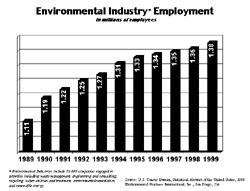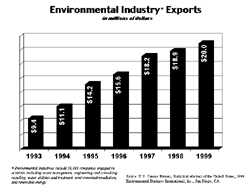| |
Growing Green Business
 "For my entire career, I have believed
very deeply that a strong economy and a clean environment go hand
in hand. These past seven years, our Administration has proven it:
our economy is booming, with nearly 20 million new jobs. And our
air and water are cleaner and healthier than they have been in decades."
"For my entire career, I have believed
very deeply that a strong economy and a clean environment go hand
in hand. These past seven years, our Administration has proven it:
our economy is booming, with nearly 20 million new jobs. And our
air and water are cleaner and healthier than they have been in decades."
Vice President Al Gore
November 16, 1999
Photo: Washington, D.C., March, 2000 |
One of the most important lessons of
the past quarter-century is that environmental protection and economic
growth go hand in hand. Indeed, efforts to restore and protect the environment
have spawned tremendous new economic opportunity for Americans, with
the promise of continued growth in the years ahead.
Today the environmental industry —
which includes companies involved in cleanup, recycling, and renewable
energy — employs nearly 1.4 million Americans and generates annual
revenues of more than $185 billion. Exports of environmental goods and
services reached $20 billion last year and continue to rise. In both
employment and revenue, the environmental sector surpasses many other
well-known industries, including aerospace, petroleum refining, and
steel.
The Clinton-Gore Administration has
launched many successful initiatives to help grow green businesses in
the United States and to promote the export of U.S. technology and expertise
overseas.
Partnership for a New Generation
of Vehicles
In 1993, President Clinton and Vice
President Gore, joined by the chief executives of the Big Three automakers,
launched an innovative research partnership to develop the next generation
of cars and light-duty trucks.
Federal laboratories are collaborating
with Daimler-Chrysler, Ford, General Motors, and with the goal of developing
cars with up to triple the fuel efficiency of today's midsize models
— with no sacrifice in safety, affordability or performance. Achieving
this goal will enhance America's competitiveness, strengthen its energy
security by reducing reliance on imported oil, and achieve significant
reductions in greenhouse gas emissions.
In a major milestone, the three automakers
recently unveiled concept cars with hybrid technologies that achieve
the 80-mile-per-gallon goal. Last month, the automakers also announced
plans to begin marketing higher-efficiency vehicles that incorporate
PNGV technology in the next three to four years.
Promoting Organic Agriculture
In recent years, organic farming has
grown from a handful of experimental garden plots to a $6 billion-a-year
industry. Today more than 12,000 American farmers, most of them small-scale
producers, practice organic agriculture.
To support this growing industry and
strengthen consumer confidence, the Administration recently proposed
a uniform national standard for labeling organic food. The proposal,
slated for final action later this year, details the practices and substances
that can be used to produce crops and livestock labeled as "organic";
prohibits the use of genetic engineering, sewage sludge, and irradiation
in the production of organic food; and prohibits antibiotics in organic
livestock production.
A uniform national standard will ensure
that consumers across the country can go into any store and have full
confidence that any food product labeled "organic" meets a strict, consistent
standard no matter where it was made. It also will make it easier for
organic growers to market their products overseas.
Supporting Green Technologies
 Environmental Industries include 59,000 companies
engaged in activities including waste management, engineering and
consulting, recycling, water utilities and treatment, environmental
remediation, and renewable energy. Source: U.S. Census Bureau, Statistical
Abstract of the United States, 1999 Environmental Business International,
Inc., San Diego, CA.
Environmental Industries include 59,000 companies
engaged in activities including waste management, engineering and
consulting, recycling, water utilities and treatment, environmental
remediation, and renewable energy. Source: U.S. Census Bureau, Statistical
Abstract of the United States, 1999 Environmental Business International,
Inc., San Diego, CA. |
In 1995, Vice President Gore launched
a National Environmental Technology Strategy to strengthen partnerships
with the environmental business community and to expand the federal
government's role in spurring innovation and growth in the industry.
Key priorities include reducing regulatory and market barriers to innovation;
creating better ways to verify the environmental performance of new
technologies; and ensuring adequate investment capital to bring promising
technologies to market.
Among the initiatives launched by the
Administration are the Interagency Environmental Technology Office,
a one-stop-shop that connects about 400 businesses a year with federal
programs and works with state environmental business councils; and a
five-year, $37 million Environmental Technology Verification program
to help provide third-party verification of the performance of environmental
technologies.
Building Environmental Exports
 Source: U.S. Census Bureau, Statistical Abstract
of the United States, 1999 Environmental Business International,
Inc., San Diego, CA.
Source: U.S. Census Bureau, Statistical Abstract
of the United States, 1999 Environmental Business International,
Inc., San Diego, CA. |
The fastest-growing market for environmental
technology is overseas, where rising prosperity and population in developing
countries is creating enormous demand for the technology and expertise
needed to achieve and maintain cleaner air, cleaner water and other environmental
benefits.
U.S. exports of environmental goods
and services have more than doubled since 1993, thanks in part to programs
launched by the Administration, including:
- An Environmental Directorate established
at the Export-Import Bank in 1994 provides loans and loan guarantees
to exporters of environmental technologies. Between 1995 and 1998,
the bank provided support to an average of 50 companies a year.
- A new Environmental Technologies
Export Office at the Department of Commerce helps U.S. businesses
identify export opportunities, conducts trade promotion activities,
and promotes policies to increase free and fair trade in the environmental
sector.
- The U.S. Trade and Development Agency
helps U.S. businesses tap newly emerging markets by funding feasibility
studies, technical assistance, reverse trade missions, and conferences.
Last year, the agency provided assistance in 65 nations around the
world.
The Greening of Small Business
Much of the growth in the environmental
industry has occurred among small- and medium-sized firms. Programs
at the Small Business Administration that support smaller environmental
firms, and help other small businesses improve their environmental performance,
include:
- The HUBZone program, which helps
minority- and women-owned businesses compete for federal contracts,
certifies firms that can perform environmental engineering and construction.
- The Small Business Investment Company,
which provides venture capital for small businesses, has invested
more than $10 million in green businesses over the past two years.
- The Small Business Development Center
Program conducts workshops and seminars on hazardous waste management,
waste reduction and recycling, and pollution prevention.
- The Small Business Compliance Alliance
Project helps small businesses comply with environmental regulations.
Meeting the Recycling Challenge
America's recycling rate is the highest
in the world. Thanks to increased recycling, the U.S. will generate
less net waste this year than it did in 1992, and about the same as
it did in 1980, when there were almost 50 million fewer people. The
Administration's Jobs Through Recycling program has helped 3,200 recycling
businesses and entrepreneurs create 8,500 jobs and new recycling technologies.
To achieve even greater gains, Vice
President Gore launched the National Recycling Challenge in 1998, calling
on government, the business community, universities, and others to commit
to increased recycling. The dozens of major commitments made so far
include:
- Sony Electronics committed to opening
a recycling center at its Pittsburgh technology center to recover
valuable resources from waste electronic scrap. Glass recovered from
old televisions and computer monitors will be used in the manufacture
of new cathode ray tubes.
- IBM developed technologies to use
recovered plastics to manufacture new products, including the first
personal computer using 100 percent recycled resin for all major plastic
parts in the central processing unit.
- Ford Motor Company committed to
developing new technologies to recycle a variety of recovered materials
in the manufacture of new vehicles. The company set an annual goal
of using more than 100 million pounds of recycled plastic, rubber,
fabric, glass, wood, and paper in new vehicle components by 2002.
This chapter in PDF
format
 (341 K)
(341 K)
|

